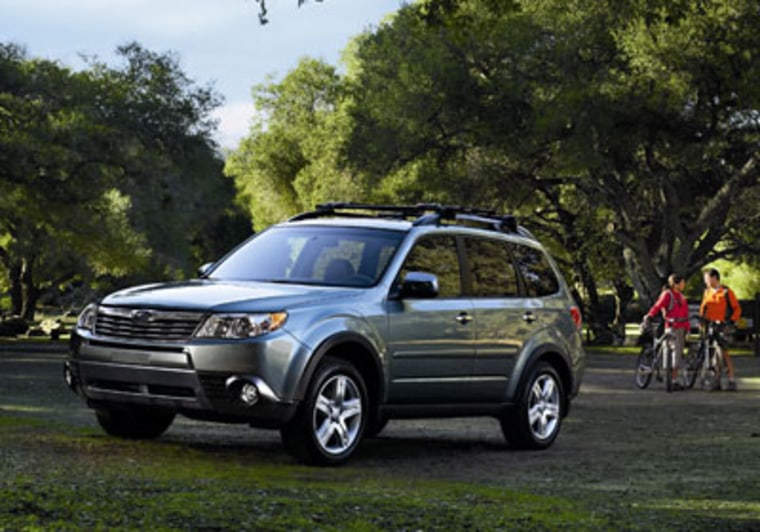Who says you have to be big or global or green to survive? A handful of car models, such as the Jeep Wrangler and the Smart, are maintaining their sales despite the general auto collapse. But the only full-sized companies that are holding their own are Korea's Hyundai and Kia, and Subaru, the Japanese automaker that builds cars in Indiana.
The Koreans have the advantage of a sharply declining home currency against the dollar. That leaves plenty of room for incentives. Plus, they've been pushing fleet sales.
But how is Subaru doing it? It has no hybrid or electric car. Its fuel efficiency is nothing special, and Subarus are definitely not the darlings of Hollywood stars. The company sells only 600,000 vehicles a year worldwide, making it maybe the 20th largest automaker.
Its major markets are Japan and then the U.S., with 187,699 sales here last year, outselling only Mitsubishi, Suzuki, and Porsche. But those 2008 sales were a notch above the year before, and first-quarter 2009 sales are a notch above, too. Subaru is proof that you don't have to be huge to hold your own.
All Subarus sold in the U.S. are all-wheel-drive, but as for looks, they're plain — even dull — family-type wagons and sedans. The exceptions are the WRX and STI models. They look plain, too — all the better not to provoke the police — but these models are for the "fast and furious" crowd who like 'em hot.
So why the success? Well, Subarus have good quality; they are always recommended by Consumer Reports. They were early into the all-wheel-drive market. Also, the Subaru engine, called a "boxer" design, is unusual — imagine a V engine turned on its side.
But there's more to the company's success, especially now. "We're fortunate. Our customer is a financially secure customer," says Executive Vice President Tom Doll. But, then, Subarus aren't expensive. They run between $20,000 to $30,000 for the most part, maybe closer to $40,000 for a just few models. Personally, I think there are people who want all-wheel-drive, but don't like the size, the gas-guzzler label, the macho looks of the other SUVs and crossovers. The Subaru crowd is terribly loyal, too, and you hardly ever hear a bad word about them.
I must admit I have a soft spot for Subaru. I once was in an accident with a Subaru wagon. Entirely my fault, a one-car accident. The Subaru was totaled, but my only injury was a tiny scratch on the palm of one hand. I figure I owe my life to Subaru.
While Japanese cars are particularly popular in California, Subaru's big regional markets are the Northeast, New England and the Pacific Northwest.
Why? Traction. The all-wheel drive is good for snow-covered roads, especially hilly snow-covered roads. That's where Subaru made its mark. Even the American headquarters is in New Jersey, not the West Coast with the other Japanese automakers (except Nissan, which moved to Tennessee to save money.
Subaru's sales hang around that 180,000 mark, but if they don't go down, they don't go up much, either. The company says it figured it was due for a breakout year. "We would have broken through 200,000 last year and this year, but for the downturn," says Doll.
Subaru is the car-making arm of Fuji Heavy Industries in Japan. At one time, Nissan owned a 20 percent share; then General Motors owned it but nothing came of that, either. Now Toyota owns one-sixth of Fuji. The Subaru plant in Indiana is shared with Toyota, which stepped in after Subaru's first partner, Isuzu, gave up and quit the U.S. market.
It was two Americans who started Subaru in America, Harvey Lamm and Malcolm Bricklin (since known for building his own sports car, for importing the Yugo, and a now-abandoned effort to create cars with a Chinese manufacturer). First, they imported a little Subaru bubble car. Later, one of the team saw an all-wheel-drive vehicle Subaru was making for the Japanese forest service, and arranged to have some built for the U.S.
That's when it began to catch on in the Northeast. Eventually, the Japanese bought out Bricklin and Lamm, but sales nosedived in the early 1990s, then recovered after Subaru decided to be all-wheel-drive-only here, and Paul Hogan, perhaps better known as Crocodile Dundee, became company spokesman.
Alas, Subaru's design efforts to break out into new sales territory have been, well, strange. There was a sports car, the SVX — seriously weird looking. There was the Baja, a wagon with a pickup back-end. And last, the Tribeca, the top-of the-line model, named after a Manhattan neighborhood, with an odd-looking front end and interior. It's been redone to look almost "normal" now, and is still on the market. Now Subaru has just shown bigger versions of its Legacy sedan and new Outback wagon, just as everyone else seems to be interested in talking about smaller vehicles.
There's no guarantee Subaru's sales will stay ahead in the maelstrom. And despite strong sales, profits are waning because of the strength of the Japanese yen and other spending. Still, Subaru seem better-off than many of its peers. Even the U.S. inventories are low, a 58-day supply of Subarus at dealers as of April 1, according to Automotive News, compared with 65 days for Toyota, 92 days for Honda and 122 days for GM.
All I can think is that virtue — building a good, unpretentious car with a reasonable price tag and high quality — is still rewarded in the auto world. And that can't be bad.
